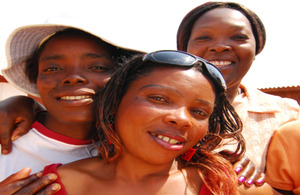DFID Research: Shaping the future of HIV: Drivers and women
With a larger proportion of women now living with HIV than men, STRIVE examine the network of influences which cause this increased vulnerability, and work to develop effective interventions.

A sex worker with her support group. Picture: Chris Morgan / Department for International Development
Tackling the Structural Drivers of the HIV Epidemic (STRIVE) is a DFID funded research consortium designed to conduct coordinated rigorous research across India, South Africa and Tanzania. Each of these countries experiences its own unique battles with HIV. Led by the London School of Hygiene and Tropical Medicine, STRIVE uses a comparative lens to establish a strong evidence base and build understanding of the diverse factors which contribute to the continued spread of HIV.
Since its discovery in 1981, over 30 years of research have gone into developing methods for preventing the spread of HIV AIDS; some preventative methods have succeeded, others have not. STRIVE works towards building better understanding of the social, economic and cultural forces that have impeded the success of interventions in its target countries and more specifically in key social groups.
The consortium identifies four key upstream determinants that shape its research:
- Gender and Inequality
- Poor livelihood options
- Alcohol availability and drinking norms
- Stigma and criminalisation
Empirical evidence clearly links each of these factors with the HIV epidemic. STRIVE research examines not only how these forces impact upon populations but how they interact with one another creating a network of forces around certain individuals.
This is clearly illustrated in a ****new video** released by STRIVE depicting how these multiple drivers specifically combine and impact upon women**.
With a larger proportion of women now living with HIV than men, researchers are working towards understanding this increased vulnerability in the hope of developing effective interventions.
However, tackling this challenge involves identifying the right questions and finding the right entry points for intervention. By unpacking the aspects of each determinant in relation to women, core themes begin to emerge which help develop effective interventions.
The video outlines the varying manifestations of each determinant in the lives of women. Often these factors are beyond the woman’s control.
- It highlights how gender inequality and the restrictions placed upon women mean that it is often the male partner’s sexual behaviour which puts the woman at risk
- This is further compounded by lack of education or opportunity for employment making the woman dependent on her partner, giving her less power in the relationship
- The stigma surrounding HIV is exacerbated by the stigma surrounding sexual relationships and unmarried women, meaning many do not discuss it or come forward fro treatment
- Availability of alcohol in unsupervised premises means that women are more likely to suffer abuse leading to further disempowerment
These issues demand interventions which look at the social and cultural aspects that increase vulnerabilities. STRIVE and its partners are already working on community programmes that attempt to combat these drivers.
The video outlines the different pathways to solutions, interventions which are already being implemented by different STRIVE affiliated programmes:
- Parivartan is a programme operating across Mumbai which uses coaching in cricket to promote gender equity among young athletes between 10 and 16 years old
- Sex-worker Community Based Organisations are providing forums for women to discuss HIV, reducing stigma and raising awareness of access to resources
- Phuza Wize is a campaign run by STRIVE affiliate Soul City which aims to change social norms around drinking and domestic abuse through local media, booklets and factsheets
By examining the complex structures that shape each social group, STRIVE is able to identify the different pathways which lead to HIV. Working with communities to build networks and reduce marginalization, the programme can develop social interventions for the drivers of HIV, rather than medical interventions for the consequences of HIV, in the hope that this will provide a gradual way out of a thirty-year struggle.